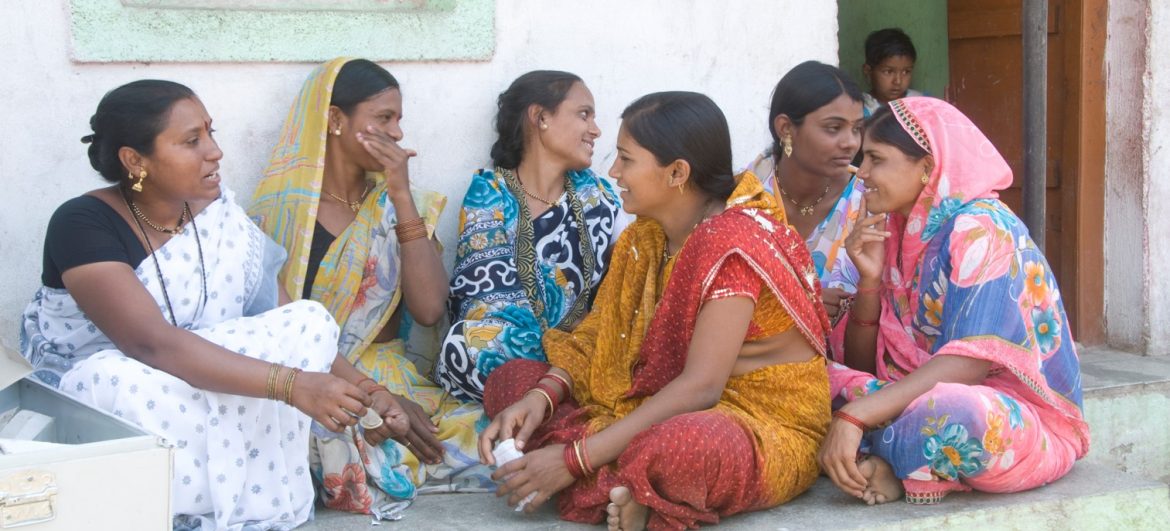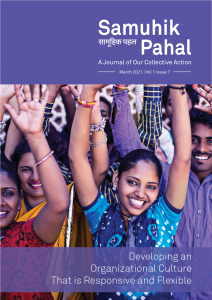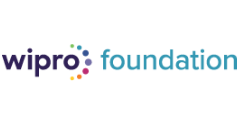Quis autem velum iure reprehe nderit. Lorem ipsum dolor sit nulla or narjusto laoreet onse ctetur adipisci.

Introducing ‘A Guide to Organizational Capacity Assessment Tools’
For the purpose of our discussion here, let’s define the ‘capacity’ of an NGO as, “the ability (a wide range of capabilities, knowledge, and resources) of non-profit organizations to fulfill their missions in an effective manner”. And therefore, Capacity Building would be – supporting activities that help an organization build its capacity.
Capacity building is not simply participating in workshops or hiring consultants to engage in strategic planning. It is about implementing the learning from those activities that will strengthen an organization.
The skills and systems learned must be translated into day‐to‐day operations so that they become part of the organization’s culture. In other words, capacity building involves change – what to change, how to change, and incorporating those changes into the daily routine of organizational life.
Ultimately, capacity building is a means to an end and the organization needs to ask itself: what is the end goal?
Building capacity can seem never‐ending, as a change in one area often impacts others, thereby requiring further change. Therefore, capacity building should be seen as an ongoing process and not as a one-time effort. That’s where ‘Frameworks for Capacity Building’ can help bring clarity of goals and objectives and provide an appropriate structure, without which capacity-building activities can seem disconnected and piecemeal.
There are many frameworks and tools that can help organizations during different stages of the capacity-building process. A large number of these frameworks focus on similar elements of the organization but the main difference is in how those elements are groups into components. Regardless of the organization’s size, domain, and specific areas of capacity, there is one key factor/step that needs to be considered in order to effectively build the capacity of the organization, that is – the entire effort of capacity-building should be ‘Assessment-based’.
A thorough assessment of its needs and assets can help the organization understand its current status and goals for growth. It can then help in the planning of priorities and measures for progress. Here again, a variety of comprehensive tools are available to help nonprofits perform Organisation-level Capacity Assessments. An organizational assessment tool provides funders and nonprofits with a framework to prompt organized thinking about an organization’s trajectory, first by individuals as they work their way through the questions and then in shared or collective discussions.
The use of a tool will identify common concerns shared by stakeholders as well as diverging opinions. A tool has merit if it supports an efficient process for understanding an organization’s strengths and weaknesses, and identifies capacity areas needing attention.
A good starting point could be “A Guide to Organizational Capacity Assessment Tools: Finding and Using the Right Tool for the Job” from William & Flora Hewlett Foundation. In 2017, William and Flora Hewlett Foundation’s Effective Philanthropy Group (EPG) partnered with ‘Informing Change’ to better understand the landscape of existing (publicly available) Organizational Capacity Assessment tools, and to outline best practices for using these tools in various contexts. The result of this exercise was a database of organizational assessment tools they assembled and a guide to using them.
The people involved wanted to gain a deeper understanding of the experiences people have when they are selecting and actually using organizational assessment tools and to better understand the contexts in which a tool might be more or less useful. To achieve this, they interviewed funders, leaders of non-profit organizations, and consultants.
The ‘Guide’ puts across the learning/findings from these interviews in insightful ways. It covers important aspects of any tool usage like how does a successful usage of tools look like, selection of appropriate tools, (specific) situations for using tools, aids to selecting a tool, and things to keep in mind (cross-cutting learning).
The guide starts with a short section on ‘how does a successful Organisational Assessment experience look like?’ highlighting important aspects, like a shared interest, time-frame, accountability, individual reflection, collective meaning-making, and commitment to action, which play a key role in effective execution of an assessment.
The next section covers ‘overarching learning’ from non-profits’ usage from a range of tools. Some of the key learnings discussed in this section include the importance of adaptation, the need to focus on the process more than a tool, the power of good facilitation processes, and the significance of selecting the right tool.
The most important section of the Guide, ‘selecting a tool’, intends to help users choose an appropriate tool for their purpose and context. It emphasizes that the right tool not just tries to elicit information about an organization but also acts as a lever for change.
This section tries to explore factors that can help match organization needs with contextual features better. Some of the factors explored include the purpose of assessment, organizational characteristics (size, budget, culture, leadership, needs, and logistics), organizational priorities, and different variables of the tools.
The next section discusses specific situations in which non-profits and funders have used these tools and shares findings from those experiences. It also provides some important questions for non-profits that can help them plan the organizational assessment process in a more informed way.
This section also explores situations relevant for funders and discusses some useful insights for them. The last section before the ‘Conclusions’ introduces the Organisational Assessment Tools Database and provides some instructions on how to use the database.
The Guide reiterates a few critical things as reminders to users. First, clarity on the organization’s needs, ultimate goals, and intentions for using the results, as well as logistical characteristics, makes it easier to find tools that can meet its needs.
Second, the database was designed to help users narrow down their search for a tool, and there is no ‘one best tool’ for a situation.
It is up to the user to select a tool that they like and that best fits with their time, budget, resources, and organizational capacity development needs. Third, a tool should prompt and support organizational reflection, decision-making, and improvements.
Bibliographic Details: A Guide to Organizational Capacity Assessment Tools: Finding and Using the Right Tool for the Job. Prepared by ‘Informing Change’
for William and Flora Hewlett Foundation. First Published in October 2017.
References: Connolly, P. & Lukas, C. (2002). Strengthening nonprofit performance: A funder’s guide to capacity building. St. Paul, MN: Amherst H. Wilder Foundation. Light, P. & Hubbard, E. (2002). The capacity-building challenge. Washington, DC: Brookings Institution.
Download: A Guide to Organizational Capacity Assessment Tools

Suggested Reading: Samuhik Pahal | Vol 1, Issue 7 by Wipro Foundation – issuu, an issue where we focus on the importance of reflexive organizational practices and how these help us create inclusive organizational cultures and build capacities for being more effective in our work.
